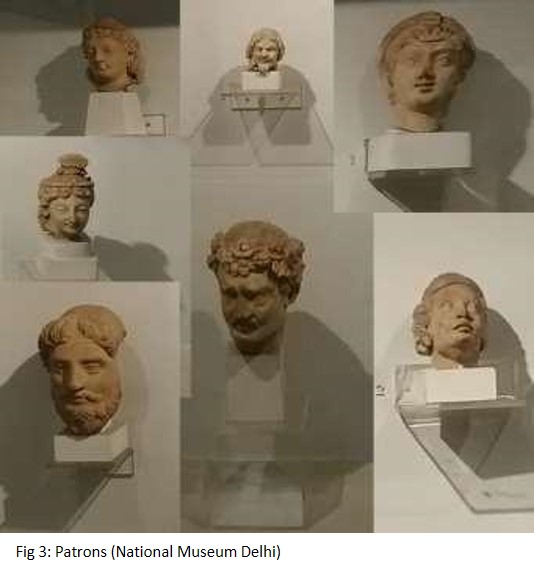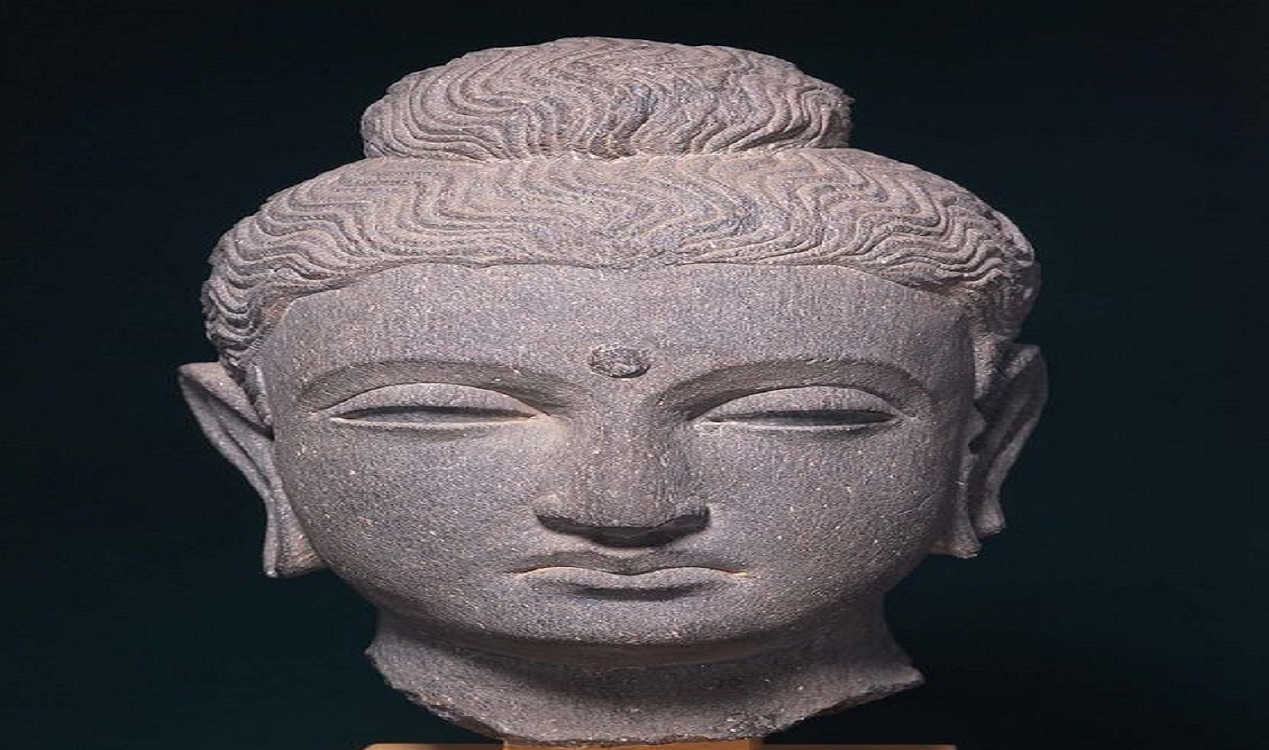The Indian Subcontinent has always been at the crossroads of some major trade networks, such as the Silk Routes trade as well as the Indian Ocean trade. The Silk Routes trade and the Indian Ocean trade have both been looked at separately by most scholars in the field. Most scholar[1] study them as two isolated trade networks and not as a dynamic network of trade which has formed over time and works at the same time with the knowledge of the existence of these alternate networks. Taking place in the same time period (early 1st millennium CE) these need to be studied together instead of as two isolated trade networks, on both a local and global scale. Moreover, the integral role of the Indian subcontinent in trans-regional trade networks is still often overlooked in archaeological studies dealing with the ancient Silk Routes.
Silk Routes
The well-known Silk Routes trade is one of the most dynamic and intricate trade networks of the ancient world. Silk routes trade refers to the trade taking place between the East and the West and was a conduit of exchange of not only silk textiles for which is named after but also cultural exchange between these two regions.[2] Over time, a lot of emphasis has been given to the East and West dynamics of the trade network, and while that is an important aspect there was also a lot of activity taking place in-between these East and West block dynamics. The exchange of objects and the cultural exchanges taking place between these regions allowed the exchange of ideas. The awareness of these different cultures was more widespread than one could imagine at that time. The Silk Routes was not just one route utilized for this exchange of goods but in fact was a complex network of various trade routes which made the Silk Routes trade a whole trade network with a web of intricate trade routes branching out. It is essential to keep all these factors in mind while looking at the Silk Routes trade as these webs of exchange play an important part in making Silk Routes trade a success and a flourishing trade network. Other important aspect is the sea trade taking place at the time which is considered a part of the Silk Routes trade but is seldom given enough emphasis to gain insights to form the connections between the terrestrial and the sea trade taking place.
Indian Ocean Trade
Indian Ocean trade has connected the east and the west through trade taking place via sea connections. This network spans from the east coast of Africa, through the Middle East, to western and eastern India, and then on through Burma to the different islands of South-east Asia. Indian Ocean trade started taking place from the ancient times and continued on after that for a long period of time with shifts in the hegemony of the trade network. This trade network goes back to the Indus valley civilization and their trade relations with the Mesopotamian as well as the Egyptian civilizations.[3] The Indian Ocean trade witnessed the exchange of huge a variety of goods in the form of finished goods as well as raw materials at times. The trade network is most of the time studied as a single trade network instead of factoring in the other trade networks active at the time. Some of the important centers of the Indian subcontinent were Gujarat, Konkan and the Malabar Coast and in the east coast of the subcontinent the Coromandel Coast in the Bay of Bengal. Several ports of these centers have been described in detail in the Periplus of the Erythraean Sea, a travel document written by a merchant about the trade taking place through the Indian Ocean. The most researched ancient ports of India studying the Indian Ocean trade are the ports of South India like the port site of Arikamedu. There are also several such port sites in Ceylon, modern day Sri Lanka an island nation south of India in the Indian Ocean[4].
While studying these trade networks, most of the time, a number of studies focus on the larger empires, such as Rome in the west and China in the east. Though these empires do play a significant role they are not the only players participating in these trade activities. Areas connecting these two regions play a much more important role and this paper will focus on these in-between regions by showcasing the diversity witnessed by one such example, Gandhara. [5]
Gandhara Region

The region of Gandhara used to comprise of the northwest portion of the Indian subcontinent which is modern day nations of India, Pakistan and Afghanistan. One of the most important regions of Gandhara was Taxila, which was well known as an important Buddhist center as well as a center of learning. Taxila was situated in the middle of the three great trade routes of the early historic times, one from eastern India running from Pataliputra to the north west of the Mauryan Empire, second from Western Asia through Bactria to Taxila and the third From the Central Asia to the Haripura valley.[6] The region hosted various cities like the Bhir mound city, Sirkap, Sirsukh along with other smaller sites with monumental Stupa architecture and some temples scattered around the region. The region owed its prosperity mostly to the trade networks and the flow of exchange which allowed it to obtain a certain monopoly in the region in the aspect of trade and when these trade contacts were interrupted the region started losing its significance. [7]
The Gandhara region has a long history and has witnessed its own fair share of shifts in the power dynamics of the region. The earliest historical sources of the region come from the Epics like Ramayana, Mahabharat and some Buddhist texts such as mentions in the Jatakas, though the archaeological evidences suggest that the city was formed a bit later than the dates ascribed by these written sources. Alexander’s campaign made the region more popular among the classical texts a well as some of the Indian textual sources. Prior to the Alexander’s campaign the region was under the Achaemenid rule. The region was well known for its Hellenistic attributes though the region was not under the Greek rule for long and was conquered by Chandragupta Maurya and became a part of the Mauryan Empire. It was through Asoka, the grandson of Chandragupta, that Buddhism reached this area and became a stronghold the religion in the region. After the fall of the Muaryan Empire the region was open to Bactrian and Parthian invasion and witnessed some instability. This was soon countered by the Kushan rule established in the region which gave back the stability, the region used to enjoy. [8]
Taxila was first excavated in the year 1863-64 by the first Director-General of the Archaeological survey of India, Sir Alexander Cunningham which was later taken up by Sir John Marshall in 1902 who came to India after conducting excavations in Greece and in his own words, “filled with enthusiasm for anything Greek”. The sculptural figures discovered from the excavations show highly western influences though the figures themselves are a part of the Buddhist material culture. They are considered a combination of Hellenistic artistic motifs with Buddhist ideas[9]. Though Buddhism is not the only religion prevalent in the region as Hellenistic temples are also found scattered around the region and are sometimes also a part of city. The temples are also of Greek gods though they are usually dedicated to a local form of Greek god[10].
The Gandharan art flourished under the Kushan Empire, which in itself is an interesting aspect to consider while studying the region of Gandhara as Kushan Empire was divided by four artistic regions Bactria (Tocharistan in the basin of the Oxus (Amu Darya) and its tributaries); Arachosia and Nagarahara (Ninhar, now Kabulistan, and the Jalalabad Province of Afghanistan); Gandhara in Pakistan; and Mathura in India[11]. The diversity which can be seen throughout the Kushan Empire is evident in the Gandhara region as well. While Kushan art has been studied extensively in these different regions, not a lot of attention has been provided to the Kushan art in the Gandhara region because of the focus on the Buddhist religion as well as to detect the western influences.[12]
Biases Regarding Gandhara
There has been a strong bias in the studies of the Gandharan art. These biases can be witnessed in the form of categorizing everything Gandharan under the Indo-Greek umbrella. This in fact is not true as multiple styles of sculptures were being sculpted throughout the same time period. A lot of the sculptures found in the same context were not categorized chronologically but instead the categories were assigned on stylistic basis. This bias can be clearly seen in a state made by John Marshall “At the time (of the Taxila excavation) I was a young man, fresh from archaeological excavation in Greece and filled with enthusiasm for anything Greek, and in that far-off corner of Punjab it seemed as if I had lighted of a sudden on a bit of Greece itself.” (John Marshall 1975)

The patron portraits are sculptural representation of the people who made donations to the stupa, it could for the construction of the stupa or for the maintenance of the stupa. These patrons are commemorated by these sculptures. This is not unlike the method of inscribing the names of the people who make donations at on plaque in the present times. This was a part of the visual culture of the Gandhara region. The patron portraits are an interesting aspect to study and contribute a lot to the study of Gandharan art as well as in understanding the Gandharan culture as a whole. These portrait sculptures not only show the vast diversity but along with it the movement of people for trade as well. This diversity could be taken as evidence of trade which was taking place at the time through the Silk Routs trade. This also opens up the opportunity to look at these complex networks which were in place in those times and the dynamic nature of these networks.
These sculptures are considered to be commissioned by the people who made donations to the Stupa and their donations were commemorated by a sculpture of their faces on the Stupa itself. These were most likely a part of the decorative panels instead of the being a part of the narrative scenes from the Jataka stories which narrate the scenes from Buddha’s life, which were also a part of the Stupa architecture[13].

While these sculptures play an important role in the art history, it is really difficult to study them as archaeological sources because of the loss of context of most of these finds. These sculptures were mainly found out of context. Though current studies are more focussed on this region and the chronology of the sites they still view most of the material culture as evidence of spread of Hellenism in the East[14]. These sites are viewed either from an art historical point of view or to study the influence of Hellenism on this particular region and while both these perspectives are important, they still don’t show the whole picture or how the region functioned in the ancient times.
In a lot of cases these patron portraits are found out of context as during the excavations a lot of sculptures which appeared to be Greek were categorized separately than the sculptures which did fall into the same category. It was assumed at the time that the sculptures which appeared to look Greek had to be earlier than the ones which look to be more ‘Indian’ stylistically and these were not categorized in a chronological manner. The dating was all done through the stylistic properties of these sculptures as opposed to the other dating methods as well as the context of these finds. Though there are some patron portraits in a Japanese collection with full records which prove that these portraits were a part of the Stupa architecture and were not separate from the Stupa complex. Inscriptions along with these portraits also attest to these portraits belonging to those of the patrons.
The Hellenistic influences over the patron portraits cannot be disregarded but another fact which is as prominent is the diversity which can be witnessed through these portraits of the patrons. These are not just Greek or Indian but also Bactrian, Kushan, Arab and much more. This shows that the Hellenistic influence is not the only aspect in the region but in fact a contribution to an already diverse material culture.
While it is essential to study these sites with local perspectives in mind, one should not totally avoid looking at the connections between these local scenarios which form bigger networks. These networks help in filling up a lot of missing pieces in the local perspectives as well and should be viewed as an important step in this field of research.
The study of Gandhara has come a long way but there is still a need to look at the site with fresh eyes. The preconceived notions about the site make it difficult to look past the biases that have been present in this particular field. These kinds of discourses are quite common in the Gandharan scholarship, which makes it more important to study these sites as a whole instead of picking up parts that satisfy a repertoire and not including the other aspects which would give a clear picture.
Conclusion
The diversity visible through these patron portraits is one of the best examples to showcase the cosmopolitan nature of the Gandhara region. It also best represents the inclusive nature of the subcontinent by exhibiting such distinct portraits of people from varied ethnicity being accepted by the local people residing in the region. These portraits also show that while archaeological data such as ceramics help in determining the exchanges taking place, looking at the monumental art can also provide us with proof of these cultural exchanges taking place in the ancient Indian Subcontinent.
References
[1]Beckwith 2015; Benjamin 2018; Frankopan 2015.
[2]Wang, M. C. (2011). Buddhist Art and Architecture on the" Silk Road", Oxford University Press
[3]Anon, 2013. Indian Ocean Trade. Encyclopedia of World Trade: From Ancient Times to the Present. Pp. 503-506.
[4]Mehta, R. N. (1966). Excavation at Devnimori: A report of the excavation conducted from 1960 to 1963 (No. 8). Department of Archaeology and Ancient History, Faculty of Arts, MS University of Baroda.
[5]Behrendt, K. A. (2009). The Ancient Reuse and Recontextualization of Gandharan Images: Second to Seventh Centuries CE. South Asian Studies, 25(1), 11-27.
[6]Marshall, J. (2013). A guide to Taxila. Cambridge University Press.
[7]Marshall, J. (2013). A guide to Taxila. Cambridge University Press.
[8]Nath, S. 1999. Ancient Indian History and Civilization.
[9]Karttunen, K. (1990). Taxila-Indian City and a Stronghold of Hellenism. Arctos; Acta Philologica Fennica, 24, 85.
[10]Karttunen, K. (1990). Taxila-Indian City and a Stronghold of Hellenism. Arctos; Acta Philologica Fennica, 24, 85.
[11]Pugachenkova, G.A., Dar, S.R., Sharma, R.C., Joyenda, M.A. and Siddiqi, H. (1994). Kushan art. History of Civilizations of Central Asia, 2, pp.331-395.
[12]Pugachenkova, G.A., Dar, S.R., Sharma, R.C., Joyenda, M.A. and Siddiqi, H. (1994). Kushan art. History of Civilizations of Central Asia, 2, pp.331-395.
[13]Pugachenkova, G.A., Dar, S.R., Sharma, R.C., Joyenda, M.A. and Siddiqi, H. (1994). Kushan art. History of Civilizations of Central Asia, 2, pp.331-395.
[14]van Aerde, M. E. J. J. (2018). Revisiting Taxila: A new approach to the Greco-Buddhist archaeological record. Ancient West & East, 2018
(The paper is the author’s individual scholastic articulation. The author certifies that the article/paper is original in content, unpublished and it has not been submitted for publication/web upload elsewhere, and that the facts and figures quoted are duly referenced, as needed, and are believed to be correct). (The paper does not necessarily represent the organisational stance... More >>
Image Source: https://i.pinimg.com/564x/96/f1/60/96f16002f33311a603cd0361c7613882.jpg











Post new comment